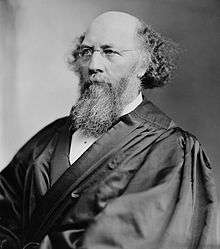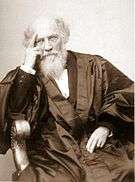Stephen Johnson Field
| Stephen Field | |
|---|---|
 | |
| Associate Justice of the Supreme Court of the United States | |
|
In office March 10, 1863 – December 1, 1897 | |
| Nominated by | Abraham Lincoln |
| Preceded by | Seat established |
| Succeeded by | Joseph McKenna |
| Chief Justice of the Supreme Court of California | |
|
In office September 20, 1859 – March 10, 1863 | |
| Appointed by | John Weller |
| Preceded by | David Terry |
| Succeeded by | Warner Cope |
| Personal details | |
| Born |
Stephen Johnson Field November 4, 1816 Haddam, Connecticut, U.S. |
| Died |
April 9, 1899 (aged 82) Washington, D.C., U.S. |
| Political party | Democratic |
| Spouse(s) | Sue Virginia Field |
| Alma mater | Williams College |
Stephen Johnson Field (November 4, 1816 – April 9, 1899) was an American jurist. He was an Associate Justice of the United States Supreme Court from March 10, 1863, to December 1, 1897. Prior to this, he was the 5th Chief Justice of California.
Early life and education
Born in Haddam, Connecticut, he was the sixth of the nine children of David Dudley Field I, a Congregationalist minister, and his wife Submit Dickinson. His family produced three other children of major prominence in 19th Century America: David Dudley Field II the prominent attorney, Cyrus Field the millionaire investor and creator of the Atlantic Cable, and Rev. Henry Martyn Field a prominent clergyman and travel writer. He grew up in Stockbridge, Massachusetts, and went to Turkey at thirteen with his sister Emilia and her missionary husband, Rev. Josiah Brewer. He received a BA from Williams College, Williamstown, Massachusetts, in 1837. While attending Williams College he was one of the original Founders of Delta Upsilon Fraternity. After reading law in Albany with Harmanus Bleecker and New York City with his brother David Dudley II, Stephen and David practiced law together until 1848 when Stephen went west to California in the Gold Rush.[1]
Career in California politics and law
In California, Field's legal practice boomed and he was elected alcalde, a form of mayor and justice of the peace under the old Mexican rule of law, of Marysville (curiously, he was elected Alcalde just three days after his arrival in Marysville).[2] Because the Gold Rush city could not afford a jail, and it cost too much to transport prisoners to San Francisco, Field implemented the whipping post, believing that without such a brutal implement many in the rough and tumble city would be hanged for minor crimes. The voters sent him to the California State Assembly in 1850 to represent Yuba County, but he lost a race the next year for the State Senate. His successful legal practice led to his election to the California Supreme Court in 1857, serving six years.[3]
During his time on the Supreme Court of California, Field had a special coat made with pockets large enough to hold two pistols so that he could shoot at his various enemies through the pockets.[4] In 1858 he was challenged to a duel by a fellow Judge (William T. Barbour) but at the dueling ground, neither man fired his gun.[5]
In 1859 Field replaced the former chief justice of the California Supreme Court, David S. Terry because Judge Terry killed a United States Senator from California (David Colbreth Broderick) in a duel and left the state. Oddly, Field and Terry's paths crossed again 30 years later when Field, acting in his capacity as a judge of the 9th Federal Circuit Court, ruled against Terry in a convoluted divorce case (and had him sent to jail for contempt of court as well). Seeking revenge, Terry attempted to kill Field in 1889 near Stockton, California but was instead shot dead by Justice Field's bodyguard, U.S. Marshal David Neagle. Ironically, legal issues arising from the killing of Mr. Terry came before the Supreme Court in the 1890 habeas corpus case of In re Neagle.[6] To no one's surprise, the Supreme Court ruled the Attorney General of the United States had authority to appoint U.S. Marshals as bodyguards to Supreme Court Justices and Marshal Neagle had acted within the scope of his authority in shooting former Judge Terry.

U.S. Supreme Court justice
On March 6, 1863, Abraham Lincoln appointed Field to the newly created tenth Supreme Court seat,[7] to achieve both regional balance (he was a Westerner) and political balance (he was a Democrat, albeit a Unionist one). The appointment would also give the Court someone familiar with real estate and mining issues. Field was confirmed by the United States Senate on March 10, 1863, and received his commission the same day.
"Field was one of the pioneers of the concept (beloved by many libertarian legal thinkers) of substantive due process — the notion that the due process protected by the Fourteenth Amendment applied not merely to procedures but to the substance of laws as well."[8] Field's vocal advocacy of substantive due process was illustrated in his dissents to the Slaughterhouse Cases and Munn v. Illinois. In the Slaughter-House Cases, Justice Field's dissent focused on the Privileges or Immunities clause, not the Due Process clause (which was important in the dissent of Justice Bradley as well as the dissent of Justice Swayne). In both Munn v Illinois and Mugler v Kansas, Justice Field based his dissent on the protection of property interests by the Due Process clause. One of Field's most notable opinions was his majority opinion in Pennoyer v. Neff, which set the standard on personal jurisdiction for the next 100 years. His views on due process were eventually adopted by the court's majority after he left the Supreme Court. In other cases he helped end the income tax (Pollock v. Farmers' Loan and Trust Company), limited antitrust law (United States v. E.C. Knight Company), and limited the power of the Interstate Commerce Commission.
On racial issues, Justice Field is regarded to have had a generally poor record.[9] He dissented in the landmark case Strauder v. West Virginia, where the majority opinion held that the exclusion of African-Americans from juries violated the Fourteenth Amendment's Equal Protection Clause. He also joined the infamous case Plessy v. Ferguson that upheld racial segregation.
Early in his career, Field wrote opinions against California's laws discriminating against the Chinese immigrants to that state.[10] Serving as an individual jurist in district court, he notably struck down the so-called 'Pigtail Ordinance' in 1879, which was regarded as discriminating against Chinese, making him unpopular with the Californian public. However, as a member of the U.S. Supreme Court, he penned opinions infused with racist anti-Chinese-American rhetoric, most notably in his majority opinion in The Chinese Exclusion Case, Chae Chan Ping v. United States, 130 U.S. 581 (1889), and in his dissent in Chew Heong v. United States, 112 U.S. 536 (1884).
Field insisted on breaking John Marshall's record of thirty-four years on the court, even though he was not able to handle the workload. His colleagues asked him to resign due to his being intermittently senile[11] but he refused, staying on until 1897. He lived only two years more, dying in Washington, D.C., and was buried there in the Rock Creek Cemetery.[12][13][14]
Justice Field's aspirations to become Chief Justice went unfulfilled, as he had made many enemies both political and personal.[15] He is the second longest serving Associate Justice.[14] Field wrote 544 opinions, more than any other justice save for Justice Samuel Miller (by comparison, Chief Justice Marshall wrote 508 opinions in his 34 years on the court).[16]
Associate Justice David Josiah Brewer was Justice Field's nephew. Other notable relatives include Paul Stephen Field and legal scholar Anne Field.
See also
Notes
- ↑ Robert Green McCloskey, American Conservatism in the Age of Enterprise, 1865-1910 (1951; Harper & Row, 1964), pp. 86-92.
- ↑ Adrian M. Tocklin, Pennoyer v. Neff: The Hidden Agenda of Stephen J. Field (Seton Hall Law Review, 1997), p. 104.
- ↑ McCloskey, American Conservatism, pp. 96-97.
- ↑ Tocklin, The Hidden Agenda, p. 102.
- ↑ Tocklin, The Hidden Agenda, p. 105.
- ↑ Gorham, George C. (2005). "The Story of the Attempted Assassination of Justice Field by a Former Associate on the Supreme Bench of California". Journal of the Supreme Court Historical Society. 30 (2): 105. doi:10.1111/j.1540-5818.2005.00102.x.
- ↑ The seat was created by 12 Stat. 794 as President Lincoln and Congress sought to change the ideological tilt of the Court.
- ↑ Doherty, Brian, Radicals for Capitalism: A Freewheeling History of the Modern American Libertarian Movement, pg. 28 (2007)
- ↑ Millhiser, Ian (March 24, 2015). "The Five Worst Supreme Court Justices In American History, Ranked". Think Progress. Center for American Progress Action Fund.
- ↑ McCloskey, American Conservatism, pp. 109-111.
- ↑ Morris, Jeffrey B. (1981). "The Era of Mellville Weston Fuller". Supreme Court Historical Society 1981 Yearbook. Supreme Court Historical Society. Archived from the original on October 2, 2006.
- ↑ Christensen, George A. (1983),"Here Lies the Supreme Court: Gravesites of the Justices". Archived from the original on September 3, 2005. Retrieved September 3, 2005. , Yearbook, Supreme Court Historical Society.
- ↑ Christensen, George A. (2008). "Here Lies the Supreme Court: Revisited". Journal of Supreme Court History. 33 (1): 17–41. doi:10.1111/j.1540-5818.2008.00177.x..
- 1 2 Stephen Johnson Field at Find a Grave.
- ↑ Oyez Project, Official Supreme Court media, Stephen Johnson Field.
- ↑ Tocklin, The Hidden Agenda, footnote 174
Further reading
Beatty, Jack "Age of Betrayal: The Triumph of Money in America 1865-1900." Knopf, 2007.
- Abraham, Henry J. (1992). Justices and Presidents: A Political History of Appointments to the Supreme Court (3rd ed.). New York: Oxford University Press. ISBN 0-19-506557-3.
- Cushman, Clare (2001). The Supreme Court Justices: Illustrated Biographies, 1789–1995 (2nd ed.). (Supreme Court Historical Society, Congressional Quarterly Books). ISBN 1-56802-126-7.
- Frank, John P. (1995). Friedman, Leon; Israel, Fred L., eds. The Justices of the United States Supreme Court: Their Lives and Major Opinions. Chelsea House Publishers. ISBN 0-7910-1377-4.
- Hall, Kermit L., ed. (1992). The Oxford Companion to the Supreme Court of the United States. New York: Oxford University Press. ISBN 0-19-505835-6.
- Kens, Paul (1997). Justice Stephen Field: Shaping Liberty from the Gold Rush to the Gilded Age. University Press of Kansas. ISBN 978-0-7006-0817-1.
- Martin, Fenton S.; Goehlert, Robert U. (1990). The U.S. Supreme Court: A Bibliography. Washington, D.C.: Congressional Quarterly Books. ISBN 0-87187-554-3.
- Urofsky, Melvin I. (1994). The Supreme Court Justices: A Biographical Dictionary. New York: Garland Publishing. p. 590. ISBN 0-8153-1176-1.
External links
| Wikiquote has quotations related to: Stephen Johnson Field |
| Wikisource has the text of the 1911 Encyclopædia Britannica article Field, Stephen Johnson. |
- Oyez Project, Official Supreme Court media, Stephen Johnson Field.
- Stephen Johnson Field at PBS
- Stephen J. Field at Supreme Court Historical Society.
- Works by Stephen Johnson Field at Project Gutenberg
- Works by or about Stephen Johnson Field at Internet Archive
- Guide to the Stephen Johnson Field Letters Addressed to Him, 1862-1896. at The Bancroft Library
| California Assembly | ||
|---|---|---|
| New constituency | Member of the California Assembly from the 14th district 1851–1852 |
Succeeded by A. G. Caldwell |
| Legal offices | ||
| Preceded by David Terry |
Chief Justice of the Supreme Court of California 1859–1863 |
Succeeded by Warner Cope |
| New seat | Associate Justice of the Supreme Court of the United States 1863–1897 |
Succeeded by Joseph McKenna |
| | |||||||||||||||||||||||||||||||||||||||||||||||||||||
|---|---|---|---|---|---|---|---|---|---|---|---|---|---|---|---|---|---|---|---|---|---|---|---|---|---|---|---|---|---|---|---|---|---|---|---|---|---|---|---|---|---|---|---|---|---|---|---|---|---|---|---|---|---|
|
 | ||||||||||||||||||||||||||||||||||||||||||||||||||||